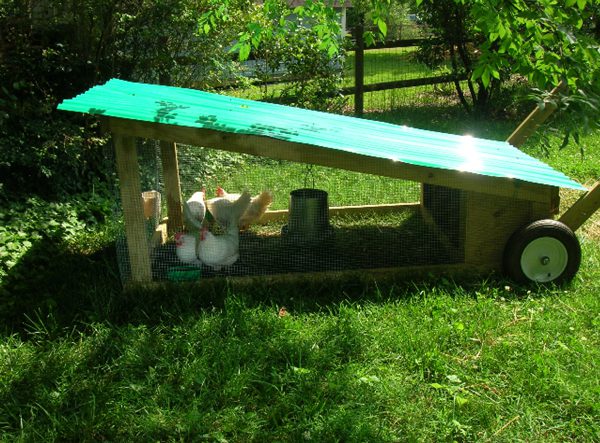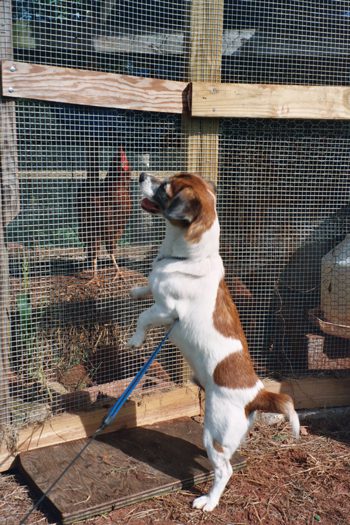We had chickens when chickens weren’t so cool

Chickens are all the rage these days. All the fashionable neighborhoods have them. I recently met a gentleman who’d built a stately coop behind his home in Charlotte’s Myers Park. In Raleigh, residents flaunt their urban flocks during the annual Hen-side the Beltline Tour de Coop.
I know these things because my husband has long been enamored with chickens. When I first brought him to the Uwharries 25 years ago, he was charmed by our land and my grandparents’ old farmhouse, but disappointed we didn’t have chickens. This was not an oversight on my family’s part. Back in the day, my grandmother had enough layers to produce about a hundred dozen eggs per week. (She sold them to J. B. Cranford, the grocer under the old Troy Hotel.) That many chickens took a lot of tending. My dad didn’t have romantic yearnings to keep a flock of yard birds.
My husband couldn’t understand this. Being an energetic and enterprising young man at the time, he set about building a coop and run. Most of the materials were recycled, in the traditional sense – repurposed or reused. Holes in the rusty chicken wire were patched with discarded window screens. An old plow served as a perch. We dubbed his efforts the Chicken Shack. After making improvements and additions, he renamed it the Chicken Palace. A series of predations inspired him to secure the perimeter with cinder blocks and thus it became the Chicken Fortress.
 He wanted beautiful chickens, not your standard Foghorn Leghorn variety. He’d drive around in the country and when he saw a promising free-range flock, he’d stop and ask the owner if he could buy some fertilized eggs. We hatched our first lot of chickens in my apartment in Chapel Hill, in an incubator borrowed from the Orange County extension office. I named them as they hatched, christening the first one Augustus to commemorate the date. That level of involvement came to no good when a weasel intervened several months later. I never named chickens again.
He wanted beautiful chickens, not your standard Foghorn Leghorn variety. He’d drive around in the country and when he saw a promising free-range flock, he’d stop and ask the owner if he could buy some fertilized eggs. We hatched our first lot of chickens in my apartment in Chapel Hill, in an incubator borrowed from the Orange County extension office. I named them as they hatched, christening the first one Augustus to commemorate the date. That level of involvement came to no good when a weasel intervened several months later. I never named chickens again.
One spring, we bought Easter chicks – Dominickers and Rhode Island Reds. For the first few weeks, we kept them in a box under a heatlamp in our garage in Charlotte. (Our Jack Russell seemed convinced he’d figure out a way to get to them if he studied on it long enough.) We ended up with a disproportionate number of roosters. It made them mean. After they made a run at my aunt’s young children, my dad had to dispatch them. The remaining hens lived a long and peaceful life.
At some point, my uncle gave us some chickens from his commercial operation. Physically, they were like Barbie dolls or female superheros – all out of proportion, if you know what I mean. Their legs were too weak to hold them. My mom put them on a diet and chased them around the yard to strengthen their muscles. They toned up real nice, but my husband wasn’t satisfied. He wanted colorful chickens.
He decided that since those chickens had been bred for meat, we were going to eat them. After talking about this for weeks, he got up early one morning and set his plan into motion, despite my reminder that it was Valentine’s Day. (Dear reader, please note – I don’t refer to him as my ex.) He lined up my dad to kill them and set himself up to do the plucking and gutting. He assured me all I’d have to do was roast one for dinner. Wouldn’t it make a romantic meal? And shouldn’t we use the wood cookstove in the old farmhouse? My mom and I weren’t impressed with the thoroughness of his cleaning, so my job was a little more grisly than promised. By the time the chicken came out of the oven, none of us had much of an appetite.
After that, he got busy with work and his interest in chickens waned a bit. The coop fell into disrepair. But I’ve begun to miss having our own fresh eggs – the sturdy shells and golden yolks – especially when I want to whip up a soufflé. Don’t be alarmed if you see a middle-aged couple in a Honda Accord slowing down to study your flock.
See the “Urban Chicken Gallery.”
Top photograph by Rea Wright. Other photograph by Ruth Ann Grissom.